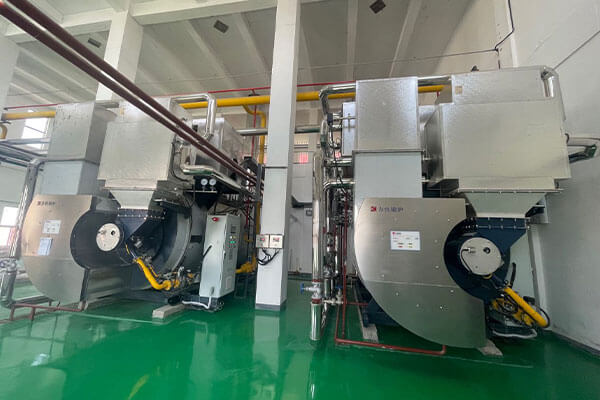Understanding Steam Dryness
Steam dryness fraction xx quantifies the proportion of vapor, with x=1.0x=1.0 denoting 100 % dry steam and x=0.95x=0.95 indicating 5 % entrained water by mass. Because latent heat is carried by vapor alone, every 1 % drop in dryness can reduce the heat transfer capability of steam by a corresponding amount. In practice, most boilers produce steam with a baseline dryness of 90–95 %, with higher values requiring separators or superheaters.
Why Dryness Matters
Energy Efficiency
Dry steam contains maximum latent heat, driving efficient heat exchange in process heaters, dryers, and turbines. Each percentage point of moisture reduces enthalpy and increases fuel consumption by several percent. In pulp-and-paper dryers—often the single largest energy consumer in a mill—maintaining steam above 96 % dryness can cut steam demand by 10–15 %.
Equipment Longevity & Safety
Water droplets in wet steam erode turbine blades, valves, and piping, accelerating maintenance cycles and risking water-hammer incidents. Corrosion from condensate carry-over also damages heat exchangers and can lead to unexpected shutdowns.
Product Quality & Compliance
Processes like sterilization, pasteurization, and textile finishing require steam above 98 % dryness to ensure uniform temperature and prevent contamination or fiber damage. Pharmaceutical autoclaves, for example, mandate saturated steam (≥ 0.98 dryness) at 121 °C for validated sterilization.
Financial & Environmental Impact
Boosting steam dryness reduces fuel use and CO₂/NOₓ emissions, aiding compliance with environmental regulations. In food and beverage plants, clean, dry steam minimizes product recalls and brand risks from steam-borne contaminants.
Key Industry Applications
-
Power Generation
Over 40 % of global electricity uses steam-cycle turbines; high dryness prevents blade erosion and maximizes turbine efficiency. -
Chemical & Petrochemical Processing
Steam drives distillation, reactors, and heat exchangers; moisture carry-over can foul catalysts and lower reaction yields. -
Pulp & Paper
Dryer sections—comprising dozens of steam-heated cylinders—consume up to 50–80 % of mill energy. Targeting ≥ 0.97 dryness reduces steam usage and improves sheet quality. -
Food & Beverage
Sterilization, cooking, and cleaning require dry steam to meet food-safety standards and avoid uneven heating or microbial risks. -
Textiles
Dry steam ensures uniform dyeing and finishes; wet steam causes stains, weakens fibers, and increases rework. -
Pharmaceuticals & Healthcare
Clean steam with minimal moisture and non-condensable gases is essential for autoclaves, sterilizers, and injections manufacturing.
Measuring & Controlling Dryness
-
Moisture Analysis Instruments
Coriolis and vortex flowmeters detect liquid carry-over; 5 % moisture can introduce 5–8 % measurement error without compensation. -
Steam Separators & Demisters
Cyclones and mesh pads installed upstream of process lines can raise steam dryness to ≥ 0.99 by removing entrained droplets. -
Superheating
Heating saturated steam above the saturation temperature eliminates residual moisture, stabilizing temperature but requiring corrosion-resistant piping. -
Routine Maintenance
Regular inspection of steam traps, moisture sensors, and separators prevents condensate carry-over and ensures accurate dryness readings. -
Automated Controls
Digital feedback systems adjust burner firing, water feed, and blowdown rates in real time to maintain target dryness fractions.
Example: Boiler Design for High Dryness
Many modern boilers integrate features that directly support steam quality:
-
Built-in Moisture Separators
Internal cyclonic demisters capture droplets before steam exits the drum, raising outlet dryness to 98 % or more. -
Condensing Economizers
By recovering latent heat from flue gases, these economizers preheat feedwater and reduce carry-over risk under low-load conditions. -
Precision PLC Control
Automated modulation of burner firing and feedwater flow keeps drum level stable, preventing water carry-over during load swings. -
Modular Skid Design
Compact, factory-assembled units simplify installation and reduce dead-legs where condensate can accumulate.
For instance, integrated condensing boilers such as those in Fangkuai’s WNS series routinely achieve outlet steam dryness of 0.98–0.99 even at 20 %–30 % load, thanks to their demister-equipped drums, low-temperature economizers, and digital control loops that tightly manage drum level and furnace temperature. This ensures that, no matter the operating profile, steam quality remains within the narrow band required by today’s most demanding processes.
Get your best price
Quickly compare 3 FREE quotes
- Engineer quick quote
- The overall delivery speed is fast
- Financial choice
- Low installation costs and cost savings
25 years+ of boiler R&D
More than 20 innovative technologies



